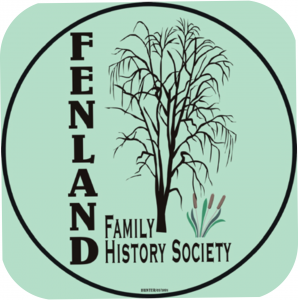Festive Member MeetingAn audience of 26 including a new member and a visitor attended the first meeting of the New Year. Members were told about future displays that the society will be involved in: at Walpole St Peters, the Heritage weekend (Leverington and St Augustine’s); in order for this to happen Bridget would like to have copes of photographs of weddings that took place during the two world wars (not necessarily weddings involving service people). If necessary Bridget can copy photographs but she does need information about the people involved (names, dates etc).
Our speaker for the evening was Susanah Farmer, who is a member of the society and is also Editor of Ag Lab. Susanah called her talk “Back to Basics” and its purpose was to encourage all of us to keep on researching our families by showing us the diverse ranges of information that are available to us. She hoped to encourage beginners to make a start and the more experienced to consider alternative lines of enquiry. Susanah also said that she hoped to show that not everyone who does family history has to be an expert or even to have everything filed away tidily! She brought with her a (large) yellow archive box which held letters, photographs, certificates, invoices and other documents; she also had a file and a hard drive. The material in the box was often the starting point for a line of enquiry and Susanah pointed out that it helped to be nosy as that’s what family history is. She also said that she picks up her research at different points often sparked by some other enquiry.
People start researching the family tree for a variety of reasons and the form that the research takes is equally varied: some people try to go back as far as possible; some try to find everyone on their tree however distantly related; some people try to locate all living relatives; others are interested in location and social history.
Susanah knew that her mother had started a family history by asking family members to write down information: this information was of variable quality but there was one lengthy letter from he r grandfather that contained information that revealed a complicated family life with some unconventional aspects. Some family members are still unaware of the relationships and Susanah urged us to be aware that some information is very sensitive and it may never be possible to determine the truth. As Susanah put it: more dotted lines on the family tree and another item on the “To do list”.
Susanah illustrated typical problems that people encounter when using transcribed records by referring to a search for a relative she knew as “Ellen Rosetta Damms”. The 1881 census was originally made available as a CD after it had been transcribed in America; Susanah could not find the family in the Downham Market area but eventually found the name had been transcribed as Danius. In a later census the girl is recorded as Rosie which also made searching more difficult. Sometimes you have to make educated guesses and then confirm the guess. Another member of that family appeared to have the forename Gately but after lots of research he turned out to have been born John David Damms (why did he change his name? another item for the “To do list”). Susanah also referred to her search for a George Davies whom she knew to be an Artillery Pensioner – this took a great deal of investigating and Susanah suggested “parking” research until another piece of evidence comes to light.
Different sources of information are increasingly available – newspapers can be a useful source of information and some of them are available online – these also come with a warning – it’s very easy to be sidetracked. Older newspapers are often useful for announcements and court cases and more recent papers (since the 1930s) may contain more gossipy information. Suasanah discovered that a family home had been destroyed in the very last air raid of the First World War and then a second family home had been destroyed in an air raid the Second World War.
Wills can provide information and can often be accessed through internet sites as well as telephone directories and some electoral register, some school records are now online. Try checking the neighbours on census records – sometimes you can work out how people came to know each other. Susanah also suggested checking the free access sites: Freecen, FreeBMD and Freereg and Family Search.
Have you tried a Google search for people or places? What about Facebook? and public family trees on sites such as Ancestry? Susanah has received photographs of her own family as a result of contacts through internet searches.
In conclusion Susanah said that she hoped she had given people the incentive to carry on researching; everyone will research in an individual way to realise that you will also have a “To do list” which will get longer and longer.
The audience thoroughly enjoyed Susanah’s talk which got everyone talking in the social time after the talk – lots of ideas were exchanged and I’m sure we all went away ready to look again at our family trees (and to create “To do lists”).
[Margaret Lake ]
October 2024 Meeting: Gilli Galloway, Governor at QEH and Volunteer Ambassador for Tapping House
At the October meeting we were delighted to welcome Gilli Galloway to talk to us about two local and well-known institutions – the Queen Elizabeth
